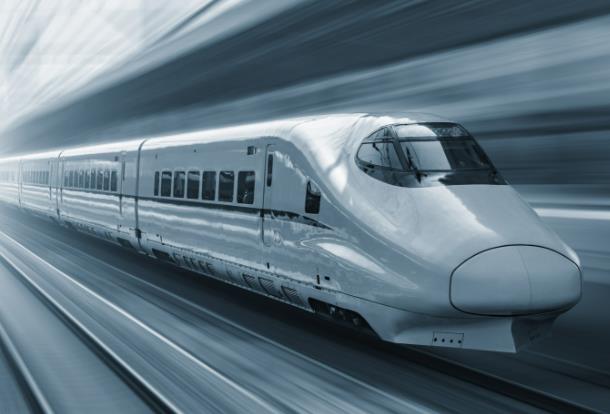Until last year, all of it would have first gone more than 1,000 miles east to Shanghai and then to Europe by sea.
But now the journey's been cut from six weeks to two. The trains are bound straight for Europe via Kazakhstan, Russia and Belarus. They will be unloaded in Poland and distributed to their final destinations.
Chinese media called their prime minister the country's top railway salesman, and when he went to London last month and trumpeted the prowess of China's railway builders, enthusiasts back home were quick to observe that China was turning the tables on one of the world's first great railway nations.
They pointed out that the nation which had brought the first rail to China 150 years ago is now agonising over its first 120-mile stretch of high-speed track between London and Birmingham, while China has already spent ?300bn ($514bn) building 8,000-miles of track and intends to double that before the end of the decade.
Foreign dependence
Until now, Chinese railway engineering has always relied on foreigners.
One hundred and fifty years ago, the British built China's first railway. The Qing Empire was suspicious of the foreign colonialists and their plans to open up China's interior by means of rail. But Europeans, Soviets and Japanese have all played a part. Even as recently as a decade ago, it was French, German and Japanese companies which brought high-speed rail to China.
But now, China has begun building its own bullet trains and indignantly denies suggestions that its advances owe anything to stolen technology. It said the story is one of "introduction, digestion, absorption and re-innovation".
Whatever the case, China's great railway adventure is picking up steam. The maps on the walls of the headquarters of the Chengdu Logistics Office make it obvious how rail can transform the fortunes of west China.
Until now, shipping goods down the Yangtse and then loading them onto ocean-going ships has enormously disadvantaged inland-China. Now, said logistics chief Chen Zhongwei, the days of foreigners knowing only coastal cities like Beijing, Shanghai and Hong Kong are over.
"We have an opportunity to narrow the gap between east and west China. We're no longer a landlocked city, we're a port city," Mr Chen said.
"No longer famous for bad roads, now we've got an international airport and a rail port. We're China's ideal jumping off point for Europe."
Railway revolution
Chengdu claims that half the world's top companies are now moving production bases west and that the software is following the hardware.
In Chengdu's business park, I watched programmers and graphic designers fine-tune Spartan Wars: Gods of Olympus. It's a new game targeting Europe and North America from a Chengdu-based company called tap4fun.
The glass walls of their offices open and close with fingerprint scanners. Their break out zone is complete with table tennis, running machines and pictures of Apple founder Steve Jobs.
Jacob Maynard from Arizona told me rail has made a huge difference.
"Transportation has actually been quite revolutionary," he said. "It has opened up lots of opportunities when before, it was an absolute nightmare. Now it is much more convenient both going west and east."The rail revolution is not without setbacks. The high-speed network opened in 2007 and was a source of enormous national pride until a crash in 2011 which killed 40 people and prompted a bout of soul-searching.
Questions about the safety of the network along with corruption revelations cost the railway minister his job and eventually the whole ministry was dismantled to be replaced by the state owned China Railway Corporation.
Deep pockets
Three years later, the mood has returned to one of pride mixed with surprise, to see China winning high-speed rail contracts around the world.
The industry website Railyway.com calls rail China's "business card abroad" and the Communist Party's Guangming Daily newspaper claims China's high speed network is "the world's fastest and best".
On his tireless foreign travels, China's Prime Minister Li Keqiang "the railway salesman" has already successfully pressed for contracts in Europe, Africa and South East Asia. Once famous as the world's factory for low-technology and labour intensive products, China is now adding bullet trains to the mix, a symbol of its ability to shift up the technology ladder.
Ambition doesn't stop there. Not content with a high-speed grid at home and lucrative railway contracts abroad, Beijing is considering both funding and building high-speed lines from west China through Central Asia to Europe and from south-west China through South East Asia to Singapore.
The challenges are immense: persuading Central Asian states to move to standard gauge tracks and tackling security to add to the enormous diplomatic, financial and technical hurdles.
But China has advantages in this game: enormous economies of scale, the absence of a political cycle to disrupt long-term planning, state-owned rail builders with deep pockets, and not least control of the media.
Back at the Chengdu cargo hub, loading is finished and the train departs on its two week journey to Europe. If China realises its dream for a high-speed route in the same direction, passengers may one day make the trip in two days.
It seems almost unimaginable but many observers would have laughed if you'd said 10 years ago that China's rail builders could come from so far behind to undercut the market leaders on their own doorstep. Watch this space.
Read the original article




